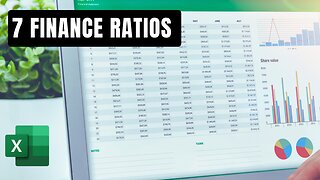How to Calculate the Gearing Ratio
How to Calculate the Gearing Ratio
The gearing ratio is a financial metric used to determine the extent to which a company is financed by debt. A higher gearing ratio indicates a greater level of debt financing and a lower level of equity financing. The gearing ratio is important because it can impact a company’s financial performance and shareholder value. Photo by Mikhail Nilov on Pexels What is the gearing ratio?
Definition of the gearing ratio.
The gearing ratio is a financial metric used to assess the degree of leverage within a company by comparing the level of debt financing to the level of equity financing....
https://finetimer.site/how-to-calculate-the-gearing-ratio/
The gearing ratio is a financial metric used to determine the extent to which a company is financed by debt. A higher gearing ratio indicates a greater level of debt financing and a lower level of equity financing. The gearing ratio is important because it can impact a company’s financial performance and shareholder value. Photo by Mikhail Nilov on Pexels What is the gearing ratio?
Definition of the gearing ratio.
The gearing ratio is a financial metric used to assess the degree of leverage within a company by comparing the level of debt financing to the level of equity financing. The higher the gearing ratio, the more leveraged a company is.
There are two types of gearing ratios: debt/equity and debt/capital. Debt/equity measures the proportion of a company’s debt financing to its equity financing. Debt/capital measures the proportion of a company’s debt financing to its total capitalization (debt + equity).
How to calculate the gearing ratio.
To calculate the gearing ratio, simply divide the total amount of debt by the total amount of equity.
For example, if a company has $100 in debt and $200 in equity, its gearing ratio would be 0.5 (100/200).
If that same company had $200 in debt and $100 in equity, its gearing ratio would be 2 (200/100).
The formula for calculating the debt/equity ratio is:
Debt/Equity = Total Debt / Total Equity
The formula for calculating the debt/capital ratio is:
Debt/Capital = Total Debt / (Total Debt + Total Equity)
What is the ideal gearing ratio?
Factors to consider when determining the ideal gearing ratio.
There are a number of factors that need to be considered when determining the ideal gearing ratio for a company. These include the company’s business risk profile, its capital structure, its liquidity position, and its debt capacity.
The business risk profile refers to the overall riskiness of the company’s business operations. Companies with higher business risks will generally require higher levels of debt in order to finance their operations. This is because lenders will often demand higher interest rates in return for lending to these companies.
The capital structure refers to the mix of debt and equity that a company has on its balance sheet. Companies with higher levels of debt will have a higher gearing ratio. This is because there is more debt relative to equity, meaning that the company is more leveraged.
The liquidity position refers to a company’s ability to meet its short-term obligations as they come due. Companies with poor liquidity positions may find it difficult to obtain new financing, and may even be forced into bankruptcy. As such, it is important for companies to maintain a strong liquidity position in order to avoid problems down the road.
Finally, companies need to consider their debt capacity when determining their ideal gearing ratio. This refers to the amount of debt that a company can safely take on without putting itself at financial risk. Companies with high levels of debt capacity can afford to take on more debt without putting themselves in jeopardy.
How To Adjust The Gearing Ratio
There are a number of ways in which companies can adjust their gearing ratios. One way is by issuing new equity or selling assets in order to raise cash and pay down debts. This will reduce the amount of leverage on the balance sheet and lower the gearing ratio accordingly. Another way is by taking on new debt financing, which will increase leverage and raise the gearing ratio.
Companies can also adjust their dividend policies in order to impact their gearing ratios. For example, if a company decides to suspend or reduce its dividend payments, this will free up cash that can be used to pay down debts or repurchase shares outstanding (thus reducing share count). This would have the effect of lowerin...
-
 2:08
2:08
AllVisuals4U | Design & Engineering
1 year ago⚙ How To Calculate Gear Ratio - Gear Ratio Explained - FreeCAD Gear Generator
57 -
 1:45
1:45
Partner
1 year agoHow to Calculate Your Rear Gear Ratio
1 -
 6:14
6:14
hauseit
4 years agoHow to Use Hauseit's Debt to Income Ratio Calculator
107 -
 12:10
12:10
TonyDenaro
3 months agoPE Ratios Explained - TTM PE Ratio vs Fwd PE Ratio for Beginners
9 -
 5:55
5:55
Patrick Bray CPA
11 months ago7 Essential Financial Ratios YOU Need to Know
8 -
 13:20
13:20
FASTGraphs
3 years ago5 - The P/E Ratio Demystified
28 -
 18:27
18:27
The SPX Investing Program
2 years ago $0.20 earnedMarket Valuation Series Part 2: Shiller PE Ratio
247 -
 6:20
6:20
Website with WordPress
1 year agoThe Only Guide to "How to Determine Your Risk Tolerance for Retirement Investing"
3 -
 13:13
13:13
Business & Finance
11 months agoHow to use DEBT to grow
18 -
 9:02
9:02
benjaminzmiller
1 year agoIs a cash out refinance a way to generate passive income?
17